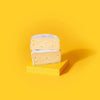5 Big Tips for your Christmas Cheeseboard
By Edward Hancock
Dec 1, 2024

1. Choosing – Which cheeses should I pick?
I love 3 showstopper cheeses if you know what you like, or 5 if you’d like to cover more styles. You need to have enough of each cheese so everybody gets a decent amount.
Next, variety is key. Both in terms of styles and visuals to make your cheeseboard pop.
3 cheeses allows you a hard, soft and blue
4 cheeses allows you to add in a different milk perhaps, sheep or goat
5 cheeses allows you to break the ‘soft’ into washed rind (eg cider washed Washington) and bloomy rind (eg Brie style Baron Bigod) or break the ‘hard’ into a cheddar and a gouda, or a territorial cheese like Lancashire.
More than 6 cheeses and you might start getting palate fatigue.
2. Quantities – How much cheese do I need?
Your next big question is going to be how much cheese to buy. Here is our handy guide:
- For a cheeseboard at the end of a big Christmas meal around 50g-75g per person
- For the main part of the meal around 100g-125g per person (isn’t cheese always the main part of the meal actually?)
- For a meal that is only cheese (how are we not already friends) around 150g-175g per person
3. Preparing – How do I ensure my cheeses taste their best?
Buy your cheese a few days in advance of serving and store in the fridge ideally, or in a larder or garage provided it is at a stable temperature of between 4-10 degrees.
The crucial piece of advice is to get your cheese to room temperature before eating. If it is too cold, the flavour will be muted, and for subtle cheeses not there at all. But don’t leave it out too long as the cheese might sweat (if wrapped) or dry out (if unwrapped).
A good way to manage the cheeses when they are getting to room temperature is to unwrap them, and then cover them with a damp tea towel. This will both prevent them getting dry, but still allow them to breath. Always keep them out of any sunlight!
4. Eating – How do I get the most out of my cheeses on the day?
It’s time to tuck in, make sure you position the cheeses in order from left to right based on their strength– your palate will thank you afterwards! We always provide an order, but generally proceed as follows:
- young fresh cheeses
- territorial cheeses
- hard aged cheeses
- soft mould ripened cheeses (Brie/washed rind etc)
- blue cheeses
What about pairing?
Territorial cheeses and cheddars are lovely with red onion jam, soft cheeses and goat’s cheeses with a drizzle of honey, and blue cheeses are delicious with pear or something sweet and fruity. Quince (or Membrillo) is delicious with hard sheep cheeses like Manchego or Spenwood.
Walnuts and hazelnuts work really nicely across a broad range of cheeses too so do experiment with that.
If you were to pick one bottle of wine for cheese, Chardonnay works a treat across a wide range of styles. Cider and beer are delicious with cheddar and territorials, full-bodied red wine works nicely with aged cheeses. A sharp white wine is great for fresh goat’s milk cheeses, whilst something richer and more oaked is great with creamy soft cheeses. Sweet wine is delicious with salty blue cheeses and of course port and Stilton is a big classic combo.
5 – The Leftovers – How do I look after my cheese?
If you do have some leftovers, wrap them back up in the same paper they came in ideally, and put them back in the fridge in a salad/separate compartment. This will prevent them from drying out too much and will also prevent any flavours from the rest of your fridge impacting your delicate cheeses. This way they will say delicious for as long as possible, ready for your next cheese tasting!


